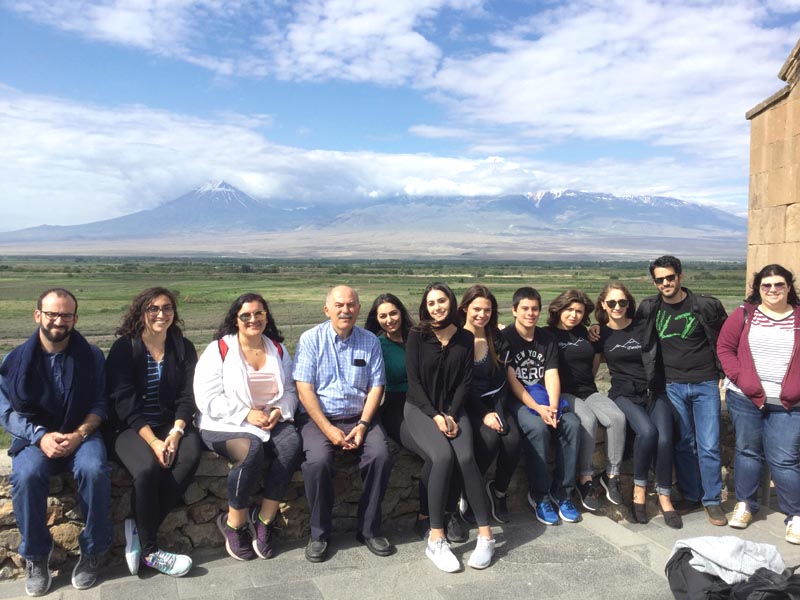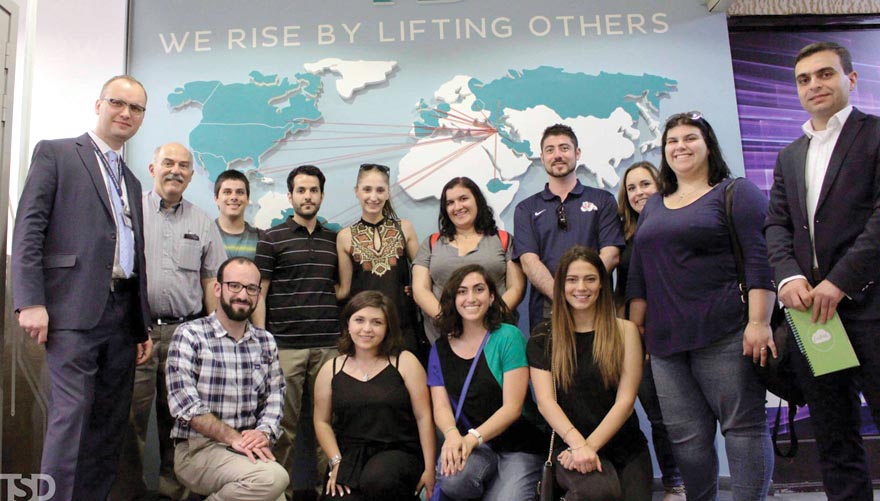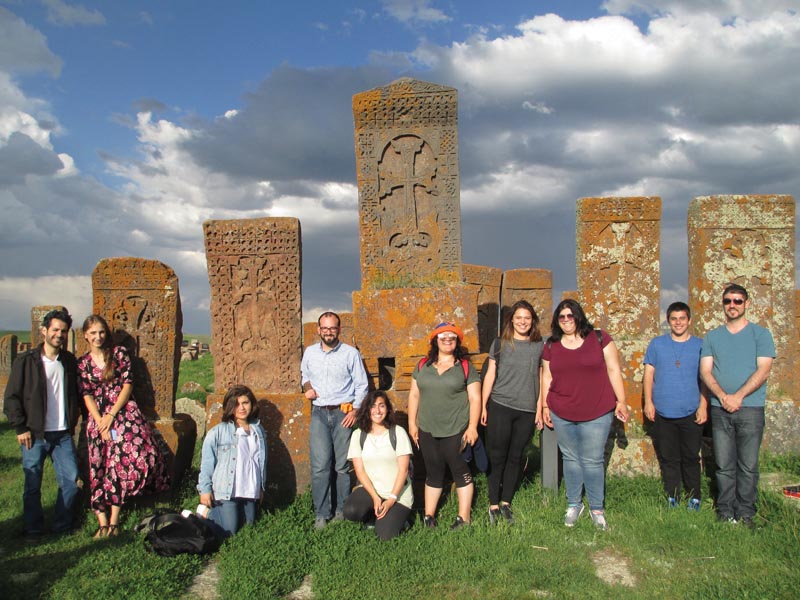
Virap, Armenia.
Photo: Hagop Ohanessian
Prof. Barlow
Der Mugrdechian
The eighth Armenia Summer Study Program took place May 24-June 9, 2017, when thirteen students and group leaders Professors Barlow Der Mugrdechian and Hagop Ohanessian arrived in sunny Yerevan.
Fresno State students have the opportunity to take Armenian Studies courses where they learn various aspects of Armenian history and culture, but an academic journey to Armenia provides an opportunity to integrate that knowledge with the experience of visiting the country.
Participating in the 2017 program were Marina Chardukian, Dikran Dzhezyan, Tatevik Hovhannisyan, Claire Kasaian, Esther Oganyan, Mary Oganyan, Shelbie Ohanesian, Mitchell Peters, Michael Rettig, Annie Rubio, David Safrazian, Kara Statler, and Marine Vardanyan.
Each Summer Study trip is different, as Prof. Der Mugrdechian strives to make each trip unique in some way. This can be a visit to an unexpected place or a meeting with some interesting people. From their base in the Ani Plaza Hotel, the students began their visit with a walking tour of central Yerevan, home to many important sites. Walking through the city gave students the chance to interact with people on the streets or in the stores.
Activities were divided between day trips to sites around the country and staying in Yerevan to visit some of the myriad cultural sites. In their visits outside of Yerevan, students visited major regions of Armenia, from Haghbat and Sanahin in the northern regions, down to Tatev in the south.

Photo: ASP Archive
Students were impressed by a visit to the TUMO Center for Creative Technologies, which provides innovative educational opportunities for children in Armenia. Thousands of children visit the after-school program, which focuses on four areas: animation, web design, filmmaking and game development. Each student creates their own personal plan, with independent learning activities. The Fresno State group was introduced to students who were developing robots and also visited one of the filmmaking studios. TUMO students also can participate in workshops led by TUMO’s workshop leaders, preparing them for future jobs.
Later the same day Fresno State students visited the offices of Technology & Science Dynamics (TSD), a leader in the high-tech field. Just this summer TSD released the first smart phones and tablets made completely in Armenia. They are on the cutting edge of technology, especially in areas such as game development and in hologram technology.
One of the highlights of the stay in Armenia was a deeply moving visit to the Armenian Martyrs Monument and the Armenian Genocide Museum at Tsitsernakapert. The Museum was remodeled and reimagined for the centenary of the Armenian Genocide in April of 2015 and students were impressed by the content and delivery of the Genocide story. Armenian Genocide Museum-Institute Director Hayk Demoyan met with the students to discuss current research efforts of the Museum. Six years ago the Armenia Summer Study Program participants had planted a tree in the Memorial Grove of the Genocide. This year’s group was proud to see that the tree had grown and were happy to water it, thereby cementing their ties to Armenia.
Fresno and Yerevan have many connections and one is through the author William Saroyan. A visit to the headquarters of the Intellectual Renaissance Foundation, home to the Saroyan House project, proved to be of great interest. Students were treated to a presentation on the plans for opening the Saroyan House Museum in Fresno on August 31, 2018.
Another Fresno connection was the Varaz Samuelian Cultural Center located in the town of Artik, just south of Gyumri. Samuelian is the artist who created the statue of David of Sassoon located in Fresno’s Courthouse Park. The Cultural Center, built with funds from Samuelian’s will, provides art lessons for the children of Artik. The Center is adorned with many of Samuelian’s paintings and is a unique and beautiful connection to Fresno.
The group’s trip coincided with a visit to Armenia by KSEE24 anchor and reporter Stefani Boorojian, accompanied by chief photographer Kevin Mahan. Booroojian and Mahan spent a brief but busy four days in Armenia. On the day before they left they met with the students and together they visited the Saroyan statue, spent time at Yerevan State University, and learned about the plans for the Saroyan House Museum in Fresno.
Booroojian and Mahan also joined the Fresno State group on a visit to Mer Hooys-House of Hope. Upon her return to Fresno Booroojian prepared an hour-long report on all of her activities in Armenia.

Photo: Barlow Der Mugrdechian
Educational moments included a special tour of the Mesrop Mashtots Matenadaran (Manuscript Library). The Matenadaran is the largest repository of Armenian manuscripts in the world. The Matenadaran and the Armenian Studies Program at Fresno State have recently been cooperating on a variety of conservation and educational projects. Students were given a guided tour of the facility, visiting the impressive gallery of ancient Armenian manuscripts, as well as areas of the Library that are not normally open to tourists.
Spiritual ties to Armenia were strengthened by visits to the Mother Cathedral of Etchmiadzin for Divine Liturgy and a blessing from Bishop Moushegh Babayan, and a visit to the St. Hripsime and St. Gayane churches. Perhaps the most moving visit was to the Monastery of Tatev in the southern region of Armenia. The day long trip included stops at Khor Virap, where St. Gregory the Illuminator had been imprisoned, followed by stops at the Areni Winery and at the Monastery of Noravank. It was early evening by the time students were sitting on the Wings of Tatev tramway headed to the Monastery of Tatev. It was a spiritual moment as the fog was moving in and the light rain that had been falling momentarily ceased.
Upon entering the Sts. Paul and Peter Cathedral, the group was blessed by Very Rev. Fr. Mikael Gevorgyan, abbot of the Monastery.
Amberd and the Monastery of Saghmosavank in the Ashtarak region of Armenia provide stark contrast to the urban life in Yerevan. A hike part way up the mountain to Amberd was an enjoyable experience as was the trip to Saghmosavank. Next door to Saghmosavank an Armenian family provided coffee and Armenian pastry to the visitors in their beautiful backyard. It was a chance for students to experience village life.
One of the culminating experiences was a visit to the United States Embassy in Yerevan and a conversation with the U.S. Ambassador to Armenia, Richard M. Mills.
Ambassador Mills spent more than an hour with the group answering questions and explaining the goals of his office. Ambassador Mills spoke extensively about U. S. sponsored projects in Armenia, specifically in the areas of business investment and agriculture.
For students and faculty alike the journey to Armenia produced unforgettable memories, but more than that students found themselves transformed.
Many had a chance to reflect on their own lives in the United States compared to life in Armenia. All left Armenia determined to return one day and to put their input into the development of the country.
 Hye Sharzhoom Armenian Action
Hye Sharzhoom Armenian Action